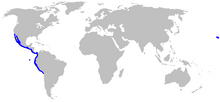Hypanus dipterurus
| Hypanus dipterurus | ||||||||||||
|---|---|---|---|---|---|---|---|---|---|---|---|---|

Hypanus dipterurus |
||||||||||||
| Systematics | ||||||||||||
|
||||||||||||
| Scientific name | ||||||||||||
| Hypanus dipterurus | ||||||||||||
| ( Jordan & Gilbert , 1880) |
Hypanus dipterurus is a species of stingray and lives in the tropical and subtropical latitudes of the eastern Pacific from southern California to northern Chile , as well as off the Galapagos Islands and Hawaii . Sightings off the coast of British Columbia remain unconfirmed to this day.
features
Hypanus dipterurus reaches a disc width of up to 1.20 meters in females and 0.86 meters in males. It has a diamond-shaped pectoral fin disc that is slightly longer than it is wide. The front seams are slightly rounded, the side corners and the muzzle are pointed. Adults have a short row of small bony bumps on their backs. The teeth are small and resemble molars , with 21 to 37 teeth in the upper jaw and 23 to 44 teeth in the lower jaw. The whip-like tail is about half the length of the disc. The top is evenly dark brown to black, the underside is raw white, the tail black.
Way of life
The ray lives close to the ground both in shallow water near the coast over sandy or muddy ground, in kelp forests and rock reefs , and at greater depths of up to 150 meters. He hunts individually or in groups of the same sex and age, which can contain up to 100 animals. Smaller fish and crustaceans are hunted, some of which are dug out of the ground with the help of the tail. Dasyatis brevis is ovoviviparous with litters of one to four young animals that are born in a yolk sac with disc widths of 18 to 23 cm . Its maximum age is estimated to be around 28 years. The rays are regularly brought in as bycatch off Mexico , mostly by crab fishermen .
Systematics
The species was described independently by Garman as Trygon brevis and by Jordan & Gilbert as Dasyatis dipterura in 1880 . Garman found it was the same species in 1913 and named it Dasyatis brevis , but others stuck to the Jordan & Gilbert designation because they had published a few months earlier. According to the priority rule in biological nomenclature , according to which older names have priority over younger (later published) names, Dasyatis dipterura is the valid scientific name. When the Dasyatidae were revised in mid-2016 , the species was placed in the newly introduced genus Hypanus . Dasyatis hawaiensis , described by Jenkins in 1903 , was identified by Nishida & Nakaya as a synonym of Dasyatis brevis in 1990 .
Individual evidence
- ↑ Last, PR, Naylor, GJP & Manjaji-Matsumoto, BM (2016): A revised classification of the family Dasyatidae (Chondrichthyes: Myliobatiformes) based on new morphological and molecular insights. Zootaxa , 4139 (3): 345-368. doi: 10.11646 / zootaxa.4139.3.2
- ^ Nishida, K. and K. Nakaya (1990): Taxonomy of the genus Dasyatis (Elasmobranchii, Dasyatididae) from the North Pacific. In: Pratt Jr., HL, SH Gruber and T. Taniuchi: Elasmobranchs as living resources: advances in the biology, ecology, systematics, and the status of the fisheries. NOAA Technical Report NMFS, No. 90: 327-346.
Web links
- Hypanus dipterurus on Fishbase.org (English)
- Hypanus dipterurus on the IUCN Red List
